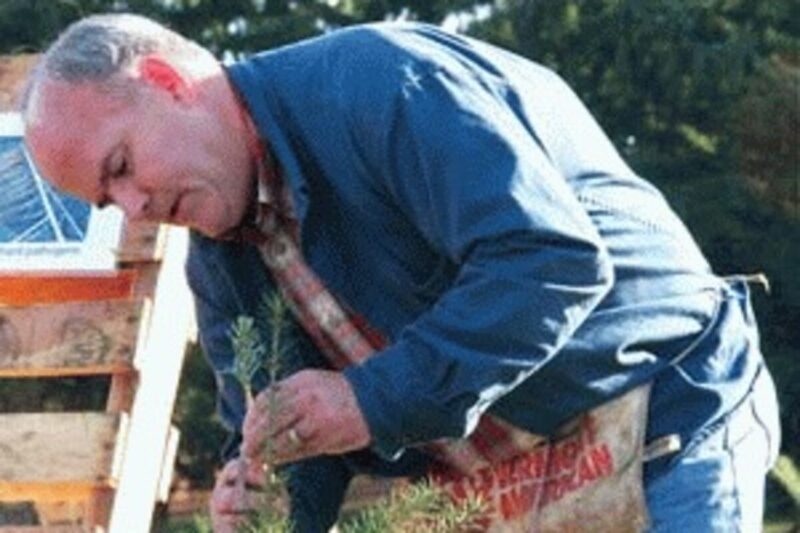Scott Swanson
Of The New Era
The mood was cautiously optimistic last Thursday as some 45 local community and business leaders and forestry experts spent the day touring seven Sweet Home-area sites to talk about the state of the logging industry in Oregon.
“In Northwest Oregon we have some of the most productive forests in the world,” Rick Fletcher, a forester with the Oregon State University Extension Service told the participants.
Fletcher and other speakers throughout the day addressed a wide range of topics including data on the ownership, timber harvest, employment and unique features of Linn County’s forests; the future of the forests; challenges faced by families who own forestland; forestry laws and practices; timber harvesting; forests and recreation; forest fire protection; old growth forests; managing forests near water; and the future of the Oregon wood products industry.
Fletcher said the idea for the tour came from a similar event held last year in Toledo, then repeated in Benton County.
Participants included representatives from nearly all the local, state and federal agencies that manage local forests, private forestry experts and forest owners, educators, chamber of commerce members, and other interested observers.
Mike Cloughesy of the Portland-based Oregon Forest Resources Institute gave the group a series of statistics on Oregon’s timber resources and those in Linn County. Cloughesy noted that at least 62 percent of Linn County is forest land, a total of some 875,000 acres. Just over half of that land belongs to private and corporate landowners, the largest – 143,309 acres – to the Hill Family, managed by Cascade Timber Consulting. Weyerhaeuser is the second-largest landowner with 92,767 acres, followed by a variety of other, smaller corporate and private owners. Public forestlands total 415,000 acres, the majority being 320,000 acres of national forest.
He said forest products and services account for 9 percent of Oregon jobs and 11 percent of the state’s total output value.
Cloughesy said that one of the more promising areas of research and development in forestry products now is the possibility of thinning and using logging slash to produce biomass that could be converted into electricity or ethanol.
He said that western Oregon logging slash alone could produce an estimated 4 million bone dry tons of woody biomass four times what could be produced from eastern Oregon which is capable of producing 610 megawatts of electricity or 256 million gallons of ethanol per year.
“We could be exporting ethanol rather than importing it,” he said.
The tour included stops at the Mason Seed Orchard on Hufford Ridge, where Bill Marshall of CTC showed how the company produces seed from various species of trees to replant its harvested lands. He said of the 3 1/2 million seedlings planted in Linn County last year, half were planted by CTC. Each year the company goes through more than 100 pounds of Douglas fir seed, produced by trees in the orchard which have been stimulated to flower and produce seed more frequently than they would under normal circumstances.
The tree breeding program, he said, allows CTC to make sure there is adequate genetic variation among the trees in its forests. He said trees are tested for height, straightness, acoustic velocity, wood density and branching before they are used to produce seed.
“Our goal as a company is to produce high-quality lumber,” he said. “That’s not true of everyone. And that’s not necessarily bad. Not everyone needs high-quality lumber. But that’s our goal.”
Participants also heard from Steve Mealey and Sherm Sallee, two smaller landowners who operate local tree farms. They discussed some of the legal and tax problems and challenges smaller landowners face, particularly when trying to pass property from one generation to another.
“American tax policy has tragic consequences for land stewardship,” Mealey said, describing some of the difficulties his family has had with land east of Foster Lake that they inherited from his father, Bob Mealey, who died last year.
Further stops included a view from a logging road of CTC property in various stages of growth and a visit to a logging site, where Mike and Scott Melcher and Jim Cota described some of the techniques and challenges of modern logging practices.
At a lunch stop at River Bend Park, Linn County Parks Director Brian Carroll talked about the development of the park, which sits partially on land donated by the Hill Family.
Lena Tucker, District Ranger for the Oregon Department of Forestry Sweet Home District, described the history of the Linn Forest Protective Association, which was founded in 1911 to protect local forests from wildfire. She noted that many of the early roads and telephone lines in the east county were the result of the LFPA’s efforts.
In more recent years, the LFPA has contracted with ODF to handle its fire protection needs, Tucker said.
She said that fire detection technology has undergone “amazing changes” in the 21st century.
Instead of staffing a fire lookout, for instance, a video camera can be used to record changes in the scenery and send its data to a control center where fire officials can look at it and determine if it is a real fire or something else, such as exhaust from a diesel engine starting up.
“It’s a little bit more efficient if you’re talking about replacing old lookout towers,” Tucker said. “For $25,000 to $30,000 you can put a camera on top of a mountain.”
Other speakers included Donna Short, department head in charge of timber sales and restoration planning for the USFS Sweet Home Ranger District.
Short told participants that the district, which produced 80 million board feet of timber a year in the 1980s, when old-growth timber was still being harvested, now produces some 8 million per year.
“It’s a different type of world now,” she said.
Short said that 1,000 to 2,000 acres of forestland in the district need thinning each year and it needs to be timed right to keep the forest healthy.
“You only have so much time to treat them before they shut down,” she said, referring to earlier explanations of how, if dominant trees are not removed while surrounding trees are growing, the surrounding trees may stop their growth process.
Oregon State University forestry professor Paul Adams explained some of the laws regarding forests that border water, noting that policies have changed drastically since the 1960s when local streams were being cleared of woodland debris because it was thought to be harmful to the health of the stream and fish. Now, he said, scientists have decided that streams need trees nearby and that some forest debris is necessary to have a healthy stream.
“The target, the idea on public and private land is to have something resembling a natural stream,” he said of laws dictating what kinds of land-use activities landowners can engage in near rivers and streams.
Adams said that forests provide shade, woody debris and hold back sediment, contributing to streams’ health.
He said that the top concern most people have in regard to rivers and streams is quality of drinking water and that laws governing logging and other activities along rivers aim to keep the water clean.
“Both public and private goals are fish-centric,” Adams said. “The idea is that if we focus on what fish need, other values will follow, such as drinking water and recreation.”
He said that continuing studies are being conducted to determine what impacts logging practices have on streams.
The final stop of the day was a tour of the new $57 million Santiam Lumber mill, built by Weyerhaeuser on the site of the old Bauman mill.
Operations Manager Brian Chaney said the mill, which opened in May, can produce lumber in 10 minutes from log to strapped unit of lumber, in green 2x4s and 2x6s in 8-, 10- and 12-foot lengths headed for Home Depot stores.





